Northcentral University, MGT-5016: Change Management Process Report
VerifiedAdded on 2022/11/29
|5
|1111
|237
Report
AI Summary
This report delves into the complexities of change management processes, emphasizing the importance of long-term commitment through stakeholder involvement, particularly within the context of Children's Healthcare of Atlanta. It advocates for the use of the Lewin change model and highlights the need for effective communication to convey the potential benefits of change, suggesting the use of short-term goals to build stakeholder confidence. The report also addresses the management of change consequences through open communication and stakeholder involvement, and it proposes strategies for overcoming contingencies, such as evaluating alternatives, benchmarking against industry standards, and fostering consensus among stakeholders to ensure the sustainability of change initiatives. The analysis underscores the critical role of communication, involvement, and strategic planning in navigating organizational change successfully.
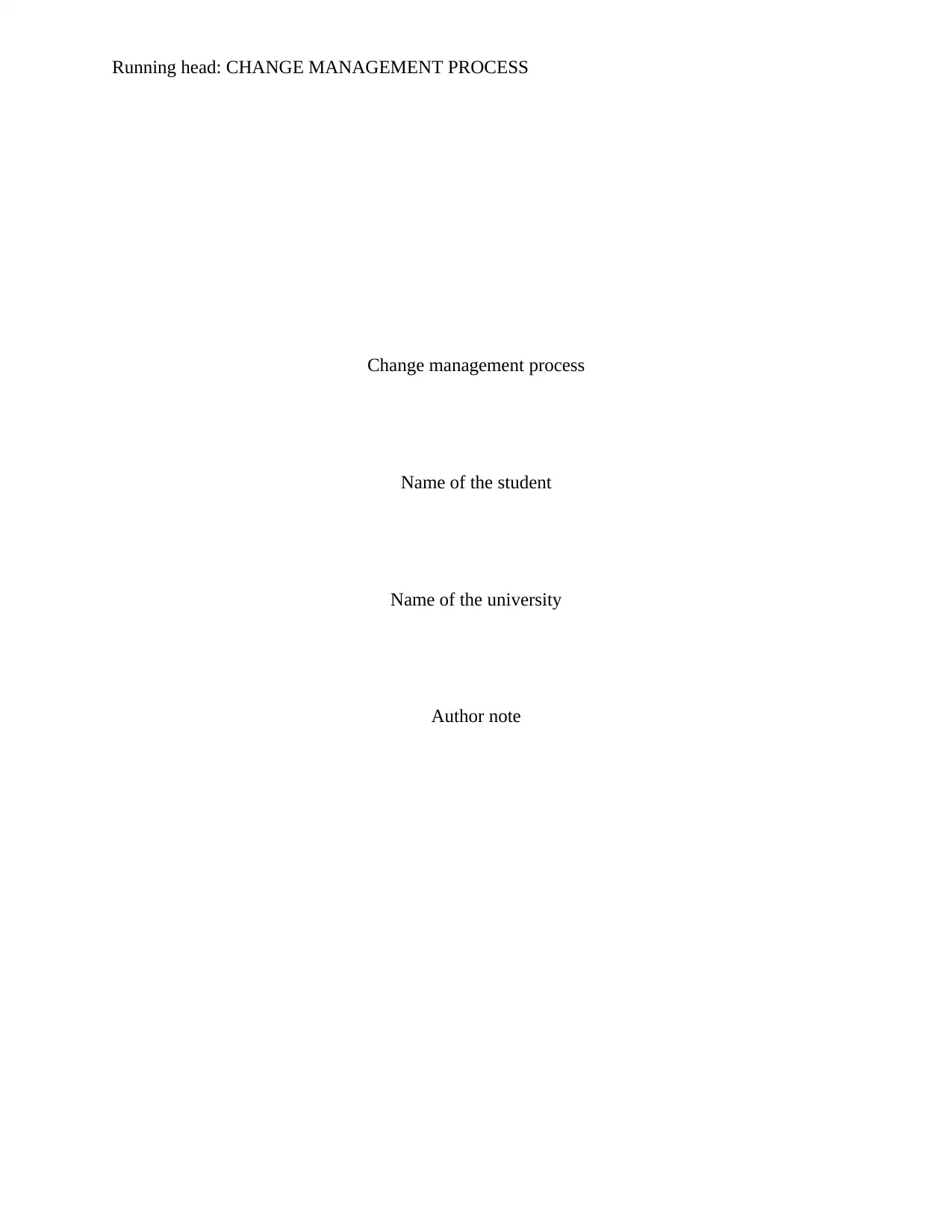
Running head: CHANGE MANAGEMENT PROCESS
Change management process
Name of the student
Name of the university
Author note
Change management process
Name of the student
Name of the university
Author note
Paraphrase This Document
Need a fresh take? Get an instant paraphrase of this document with our AI Paraphraser
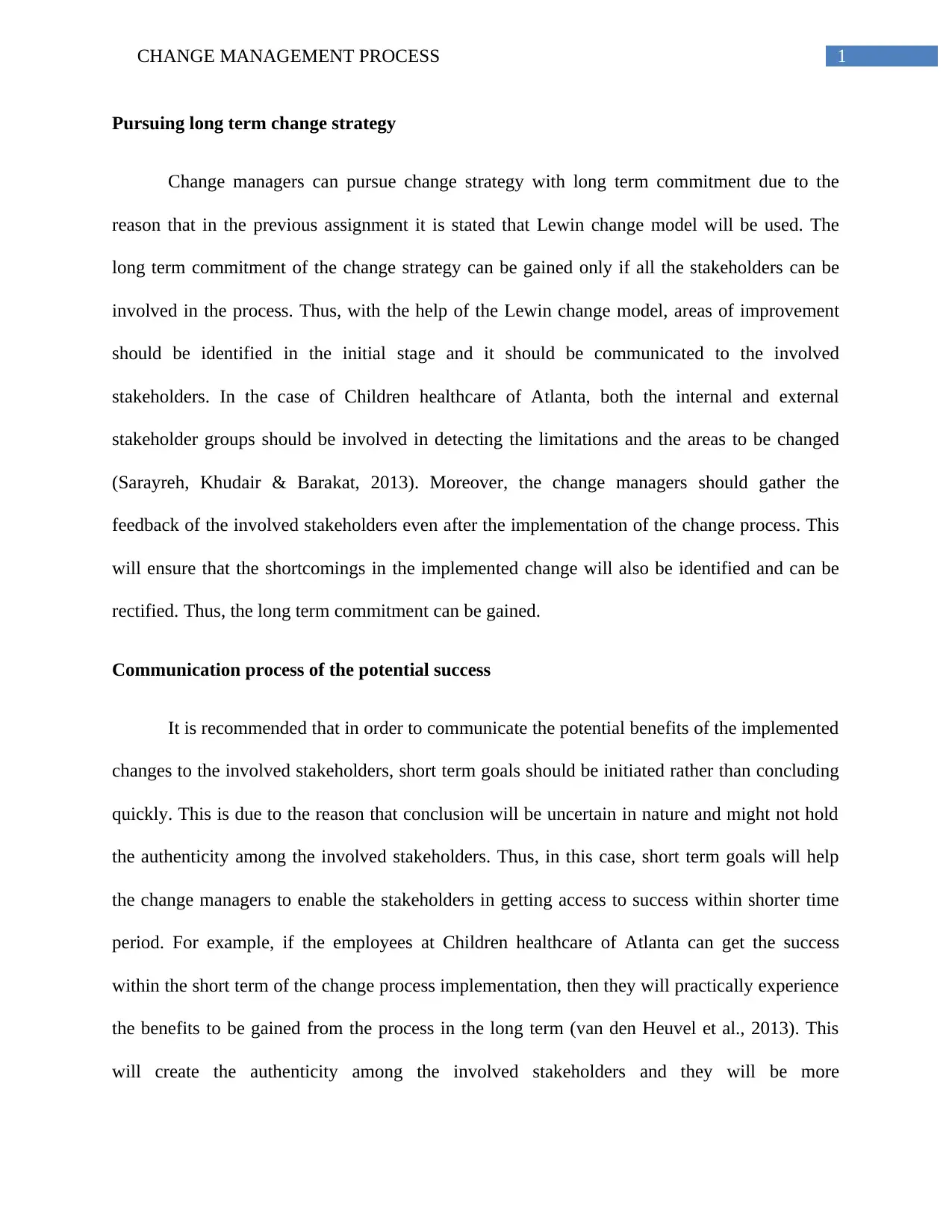
1CHANGE MANAGEMENT PROCESS
Pursuing long term change strategy
Change managers can pursue change strategy with long term commitment due to the
reason that in the previous assignment it is stated that Lewin change model will be used. The
long term commitment of the change strategy can be gained only if all the stakeholders can be
involved in the process. Thus, with the help of the Lewin change model, areas of improvement
should be identified in the initial stage and it should be communicated to the involved
stakeholders. In the case of Children healthcare of Atlanta, both the internal and external
stakeholder groups should be involved in detecting the limitations and the areas to be changed
(Sarayreh, Khudair & Barakat, 2013). Moreover, the change managers should gather the
feedback of the involved stakeholders even after the implementation of the change process. This
will ensure that the shortcomings in the implemented change will also be identified and can be
rectified. Thus, the long term commitment can be gained.
Communication process of the potential success
It is recommended that in order to communicate the potential benefits of the implemented
changes to the involved stakeholders, short term goals should be initiated rather than concluding
quickly. This is due to the reason that conclusion will be uncertain in nature and might not hold
the authenticity among the involved stakeholders. Thus, in this case, short term goals will help
the change managers to enable the stakeholders in getting access to success within shorter time
period. For example, if the employees at Children healthcare of Atlanta can get the success
within the short term of the change process implementation, then they will practically experience
the benefits to be gained from the process in the long term (van den Heuvel et al., 2013). This
will create the authenticity among the involved stakeholders and they will be more
Pursuing long term change strategy
Change managers can pursue change strategy with long term commitment due to the
reason that in the previous assignment it is stated that Lewin change model will be used. The
long term commitment of the change strategy can be gained only if all the stakeholders can be
involved in the process. Thus, with the help of the Lewin change model, areas of improvement
should be identified in the initial stage and it should be communicated to the involved
stakeholders. In the case of Children healthcare of Atlanta, both the internal and external
stakeholder groups should be involved in detecting the limitations and the areas to be changed
(Sarayreh, Khudair & Barakat, 2013). Moreover, the change managers should gather the
feedback of the involved stakeholders even after the implementation of the change process. This
will ensure that the shortcomings in the implemented change will also be identified and can be
rectified. Thus, the long term commitment can be gained.
Communication process of the potential success
It is recommended that in order to communicate the potential benefits of the implemented
changes to the involved stakeholders, short term goals should be initiated rather than concluding
quickly. This is due to the reason that conclusion will be uncertain in nature and might not hold
the authenticity among the involved stakeholders. Thus, in this case, short term goals will help
the change managers to enable the stakeholders in getting access to success within shorter time
period. For example, if the employees at Children healthcare of Atlanta can get the success
within the short term of the change process implementation, then they will practically experience
the benefits to be gained from the process in the long term (van den Heuvel et al., 2013). This
will create the authenticity among the involved stakeholders and they will be more
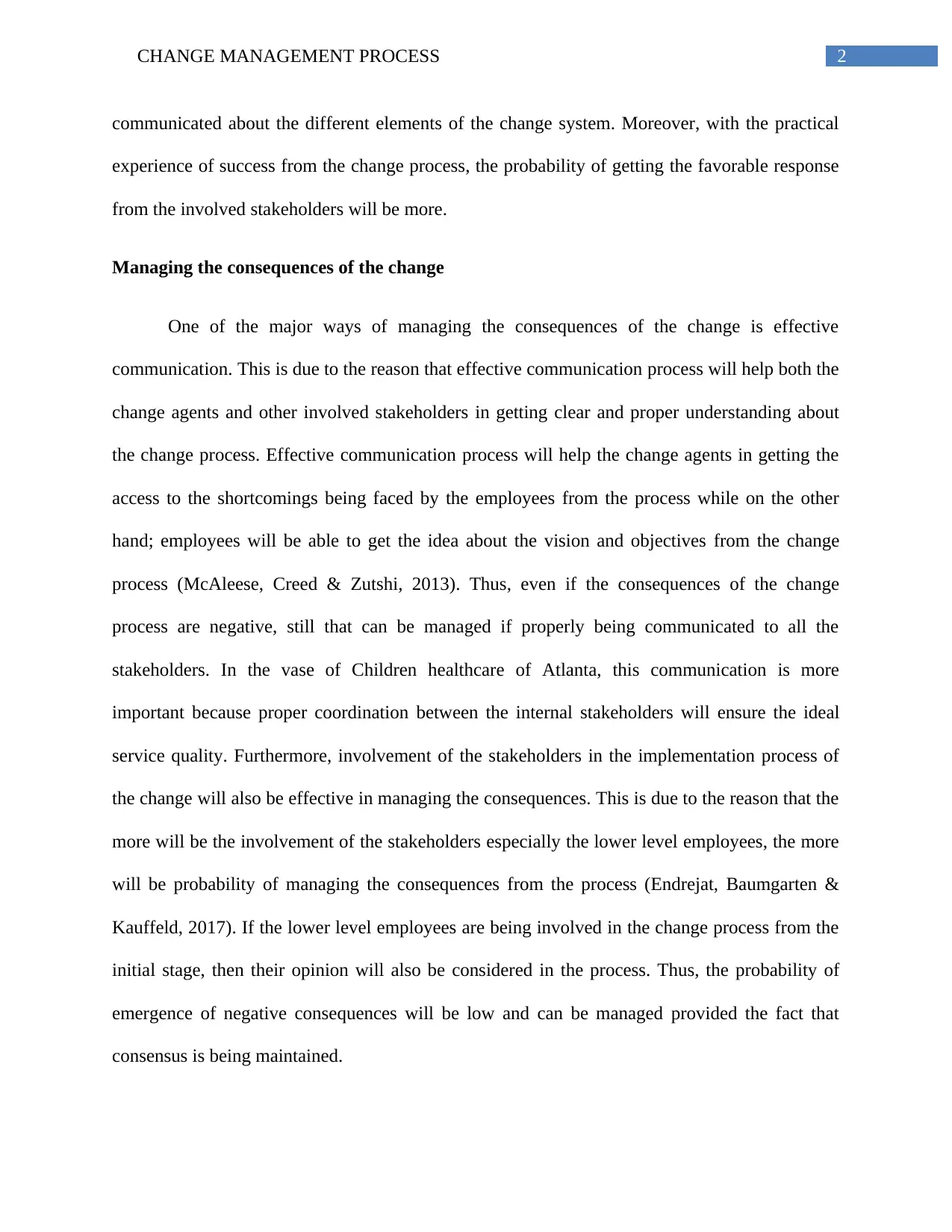
2CHANGE MANAGEMENT PROCESS
communicated about the different elements of the change system. Moreover, with the practical
experience of success from the change process, the probability of getting the favorable response
from the involved stakeholders will be more.
Managing the consequences of the change
One of the major ways of managing the consequences of the change is effective
communication. This is due to the reason that effective communication process will help both the
change agents and other involved stakeholders in getting clear and proper understanding about
the change process. Effective communication process will help the change agents in getting the
access to the shortcomings being faced by the employees from the process while on the other
hand; employees will be able to get the idea about the vision and objectives from the change
process (McAleese, Creed & Zutshi, 2013). Thus, even if the consequences of the change
process are negative, still that can be managed if properly being communicated to all the
stakeholders. In the vase of Children healthcare of Atlanta, this communication is more
important because proper coordination between the internal stakeholders will ensure the ideal
service quality. Furthermore, involvement of the stakeholders in the implementation process of
the change will also be effective in managing the consequences. This is due to the reason that the
more will be the involvement of the stakeholders especially the lower level employees, the more
will be probability of managing the consequences from the process (Endrejat, Baumgarten &
Kauffeld, 2017). If the lower level employees are being involved in the change process from the
initial stage, then their opinion will also be considered in the process. Thus, the probability of
emergence of negative consequences will be low and can be managed provided the fact that
consensus is being maintained.
communicated about the different elements of the change system. Moreover, with the practical
experience of success from the change process, the probability of getting the favorable response
from the involved stakeholders will be more.
Managing the consequences of the change
One of the major ways of managing the consequences of the change is effective
communication. This is due to the reason that effective communication process will help both the
change agents and other involved stakeholders in getting clear and proper understanding about
the change process. Effective communication process will help the change agents in getting the
access to the shortcomings being faced by the employees from the process while on the other
hand; employees will be able to get the idea about the vision and objectives from the change
process (McAleese, Creed & Zutshi, 2013). Thus, even if the consequences of the change
process are negative, still that can be managed if properly being communicated to all the
stakeholders. In the vase of Children healthcare of Atlanta, this communication is more
important because proper coordination between the internal stakeholders will ensure the ideal
service quality. Furthermore, involvement of the stakeholders in the implementation process of
the change will also be effective in managing the consequences. This is due to the reason that the
more will be the involvement of the stakeholders especially the lower level employees, the more
will be probability of managing the consequences from the process (Endrejat, Baumgarten &
Kauffeld, 2017). If the lower level employees are being involved in the change process from the
initial stage, then their opinion will also be considered in the process. Thus, the probability of
emergence of negative consequences will be low and can be managed provided the fact that
consensus is being maintained.
⊘ This is a preview!⊘
Do you want full access?
Subscribe today to unlock all pages.

Trusted by 1+ million students worldwide
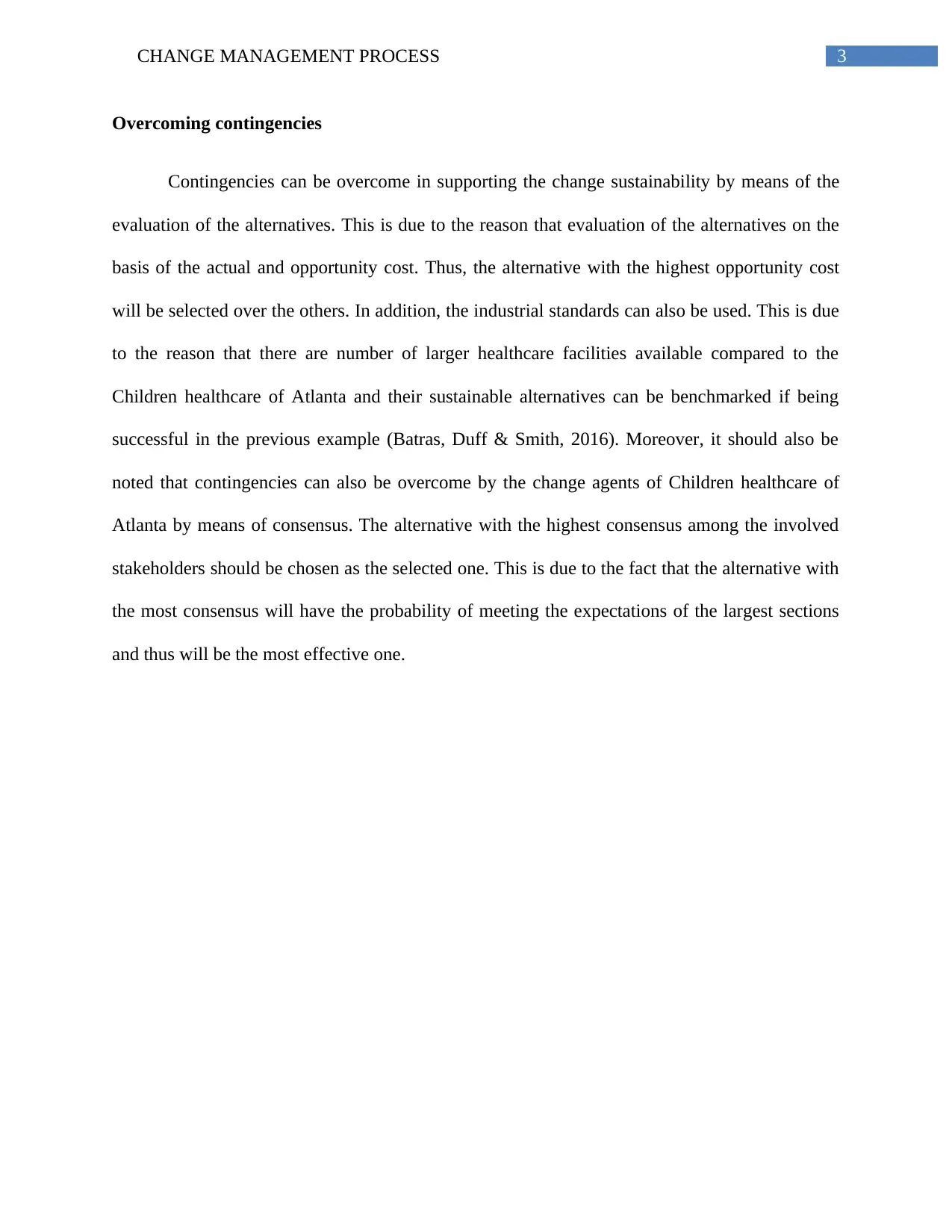
3CHANGE MANAGEMENT PROCESS
Overcoming contingencies
Contingencies can be overcome in supporting the change sustainability by means of the
evaluation of the alternatives. This is due to the reason that evaluation of the alternatives on the
basis of the actual and opportunity cost. Thus, the alternative with the highest opportunity cost
will be selected over the others. In addition, the industrial standards can also be used. This is due
to the reason that there are number of larger healthcare facilities available compared to the
Children healthcare of Atlanta and their sustainable alternatives can be benchmarked if being
successful in the previous example (Batras, Duff & Smith, 2016). Moreover, it should also be
noted that contingencies can also be overcome by the change agents of Children healthcare of
Atlanta by means of consensus. The alternative with the highest consensus among the involved
stakeholders should be chosen as the selected one. This is due to the fact that the alternative with
the most consensus will have the probability of meeting the expectations of the largest sections
and thus will be the most effective one.
Overcoming contingencies
Contingencies can be overcome in supporting the change sustainability by means of the
evaluation of the alternatives. This is due to the reason that evaluation of the alternatives on the
basis of the actual and opportunity cost. Thus, the alternative with the highest opportunity cost
will be selected over the others. In addition, the industrial standards can also be used. This is due
to the reason that there are number of larger healthcare facilities available compared to the
Children healthcare of Atlanta and their sustainable alternatives can be benchmarked if being
successful in the previous example (Batras, Duff & Smith, 2016). Moreover, it should also be
noted that contingencies can also be overcome by the change agents of Children healthcare of
Atlanta by means of consensus. The alternative with the highest consensus among the involved
stakeholders should be chosen as the selected one. This is due to the fact that the alternative with
the most consensus will have the probability of meeting the expectations of the largest sections
and thus will be the most effective one.
Paraphrase This Document
Need a fresh take? Get an instant paraphrase of this document with our AI Paraphraser
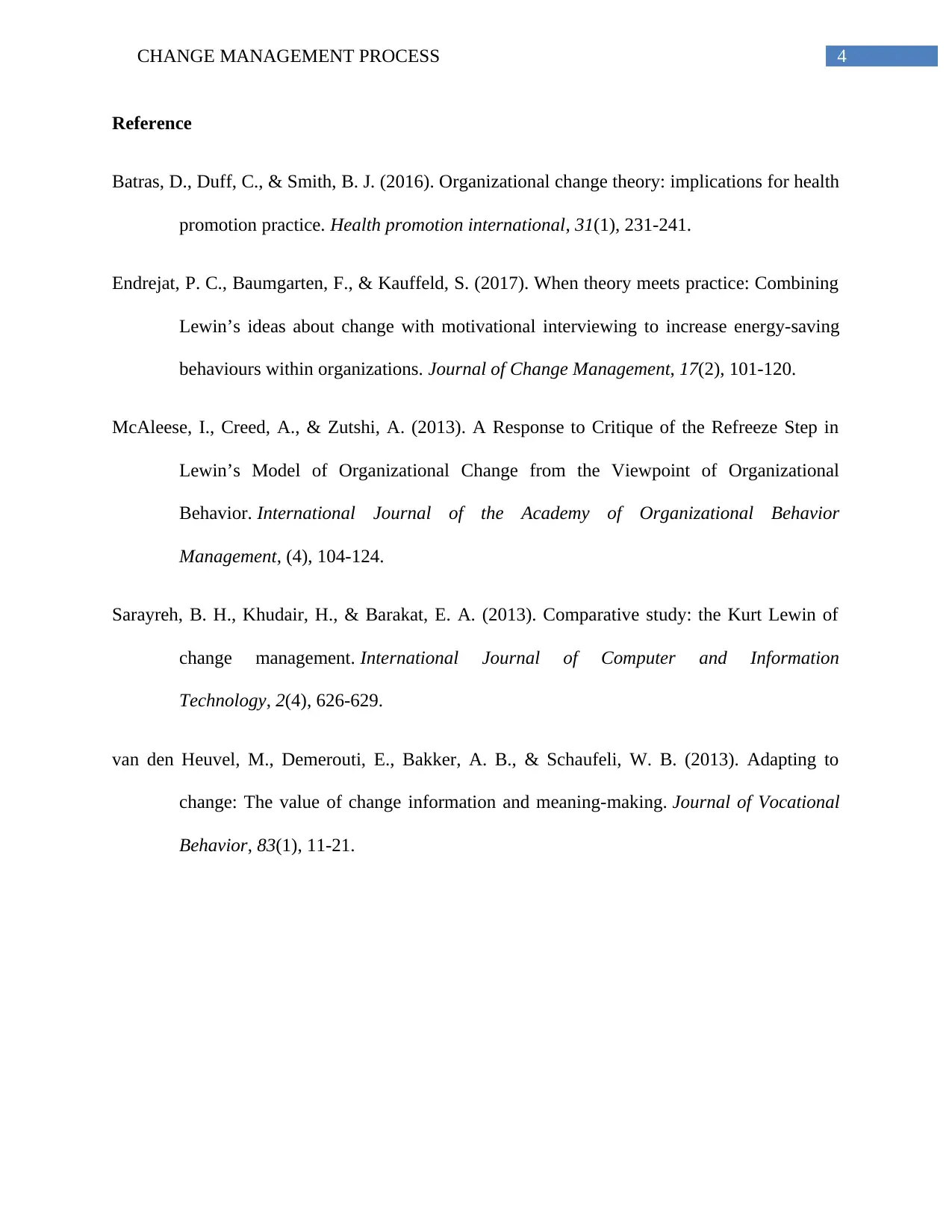
4CHANGE MANAGEMENT PROCESS
Reference
Batras, D., Duff, C., & Smith, B. J. (2016). Organizational change theory: implications for health
promotion practice. Health promotion international, 31(1), 231-241.
Endrejat, P. C., Baumgarten, F., & Kauffeld, S. (2017). When theory meets practice: Combining
Lewin’s ideas about change with motivational interviewing to increase energy-saving
behaviours within organizations. Journal of Change Management, 17(2), 101-120.
McAleese, I., Creed, A., & Zutshi, A. (2013). A Response to Critique of the Refreeze Step in
Lewin’s Model of Organizational Change from the Viewpoint of Organizational
Behavior. International Journal of the Academy of Organizational Behavior
Management, (4), 104-124.
Sarayreh, B. H., Khudair, H., & Barakat, E. A. (2013). Comparative study: the Kurt Lewin of
change management. International Journal of Computer and Information
Technology, 2(4), 626-629.
van den Heuvel, M., Demerouti, E., Bakker, A. B., & Schaufeli, W. B. (2013). Adapting to
change: The value of change information and meaning-making. Journal of Vocational
Behavior, 83(1), 11-21.
Reference
Batras, D., Duff, C., & Smith, B. J. (2016). Organizational change theory: implications for health
promotion practice. Health promotion international, 31(1), 231-241.
Endrejat, P. C., Baumgarten, F., & Kauffeld, S. (2017). When theory meets practice: Combining
Lewin’s ideas about change with motivational interviewing to increase energy-saving
behaviours within organizations. Journal of Change Management, 17(2), 101-120.
McAleese, I., Creed, A., & Zutshi, A. (2013). A Response to Critique of the Refreeze Step in
Lewin’s Model of Organizational Change from the Viewpoint of Organizational
Behavior. International Journal of the Academy of Organizational Behavior
Management, (4), 104-124.
Sarayreh, B. H., Khudair, H., & Barakat, E. A. (2013). Comparative study: the Kurt Lewin of
change management. International Journal of Computer and Information
Technology, 2(4), 626-629.
van den Heuvel, M., Demerouti, E., Bakker, A. B., & Schaufeli, W. B. (2013). Adapting to
change: The value of change information and meaning-making. Journal of Vocational
Behavior, 83(1), 11-21.
1 out of 5
Related Documents
Your All-in-One AI-Powered Toolkit for Academic Success.
+13062052269
info@desklib.com
Available 24*7 on WhatsApp / Email
![[object Object]](/_next/static/media/star-bottom.7253800d.svg)
Unlock your academic potential
Copyright © 2020–2025 A2Z Services. All Rights Reserved. Developed and managed by ZUCOL.





